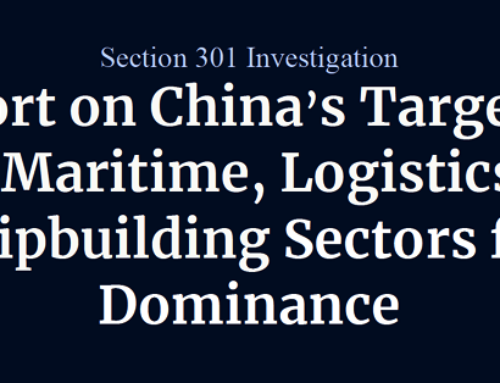The Uyghur Forced Labor Prevention Act (UFLPA) was enacted on December 23, 2021, to strengthen the existing prohibition against the importation of goods made wholly or in part with forced labor into the United States and to end the systematic use of forced labor in the Xinjiang Uyghur Autonomous Region (Xinjiang).
Among its mandates, the UFLPA charged the Forced Labor Enforcement Task Force (FLETF), chaired by the U.S. Department of Homeland Security (DHS), to develop a strategy for supporting the enforcement of Section 307 of the Tariff Act of 1930, as amended (19 U.S.C. § 1307) to prevent the importation into the United States of goods mined, produced, or manufactured wholly or in part with forced labor in the People’s Republic of China (PRC).
Enforcement of the UFLPA and application of the rebuttable presumption will apply to merchandise imported on or after June 21, 2022.
The DHS presented a detailed Strategy to Prevent the Importation of Goods Mined, Produced, or Manufactured with Forced Labor in the People’s Republic of China in a Report to Congress on June 17, 2022, just four days before enforcement of UFLPA begins.
The document provided much anticipated Guidance for Importers and links to resources for program alignment.
GUIDANCE TO IMPORTERS
The UFLPA requires CBP to apply a rebuttable presumption that all goods, wares, articles, and merchandise mined, produced, or manufactured wholly or in part in Xinjiang, or by entities on the UFLPA Entity List, are prohibited from entry into the United States under 19 U.S.C. § 1307.
The rebuttable presumption applies to downstream products that incorporate these goods as inputs,regardless of where the products are produced, i.e., to goods produced in the PRC outside Xinjiang, as well as goods produced in third countries or shipped through third countries, if they contain inputs mined, produced, or manufactured in Xinjiang or by an entity on the UFLPA Entity List.
1. Due diligence, effective supply-chain tracing, and supply-chain management measures to ensure that importers do not import any goods mined, produced, or manufactured wholly or in part with forced labor from the PRC, especially from Xinjiang;
-
- Due Diligence as detailed by U.S. Department of Labor’s Comply Chain
- Engage stakeholders and partners
- Forced labor risk assessment
- Develop a written code of conduct
- Communicate and train across supply chain
- Monitor compliance
- Remediate violations
- Independent review
- Report performance and engagement
- Effective Supply Chain Tracing
- Importers must know their suppliers and labor sources at all levels through supply chain “mapping”
- Beyond mapping, supply-chain tracing is the ability to demonstrate chain of custody of goods and materials from the beginning of the supply chain to the buyer of the finished product.
- Supply Chain Management Measures
- Effective supply-chain management measures include…
- having a process to vet potential suppliers for forced labor prior to entering a contract with them;
- requiring that supplier contracts necessitate corrective action by the supplier if forced labor is identified in the supply chain;
- outlining the consequences if corrective action is not taken, such as termination of the contractual relationship; and
- having access to documentation, personnel, and workers for verification of the absence of forced labor indicators, including at the recruitment stage.
- Importers should have an information system to manage supply-chain management data, including all mapping and risk and impact assessment information, which should be entered into this system and updated on a regular basis.
- Effective supply-chain management measures include…
- Due Diligence as detailed by U.S. Department of Labor’s Comply Chain
2. Type, nature, and extent of evidence that demonstrates that goods originating in the PRC were not mined, produced, or manufactured wholly or in part in Xinjiang; and
3. Type, nature, and extent of evidence that demonstrates that goods originating in the PRC, including goods detained or seized pursuant to 19 U.S.C. § 1307, were not mined, produced, or manufactured wholly or in part with forced labor.
DATES OF ENFORCEMENT
- Shipments imported prior to June 21, 2022, will be adjudicated through the WRO/Findings process.
- Shipments imported on or after June 21, 2022, that are subject to the UFLPA, which previously would have been subject to a Xinjiang WRO, will be processed under UFLPA procedures, and detained, excluded, or seized.
THE UFLPA IMPORT PROCESS
U.S. Customs and Border Protection also published Operational Guidance for Importers (CBP Publication No. 1793-0522) on June 13, 2022, outlining the importation process in regards to UFLPA enforcement and the type of information that may be required for impacted supply chains.
To enforce the UFLPA, CBP will take specific enforcement actions, including identifying, detaining, and/or excluding, or seizing shipments subject to the UFLPA’s rebuttable presumption, depending upon the specific facts involved in each importation.
CBP will identify shipments through a variety of sources including from the UFLPA Entity List required by Section 2(d)(2)(B) of the UFLPA and published in the Federal Register.
CBP will review each shipment for UFLPA applicability, and appropriate action to be taken, on a case-by-case basis.
- Detention
- Merchandise that is not released within the five-day period (excluding weekends and holidays) will be considered detained merchandise.
- Importers may present an Immediate Export in-bond to seek permission from the port director to export detained shipments at any point prior to exclusion or seizure.
- Merchandise that is not released within the five-day period (excluding weekends and holidays) will be considered detained merchandise.
- Release
- When an exception is granted, CBP must submit to Congress and the public a report identifying the good and the evidence considered in reaching the determination that an exception is warranted under Section 3(b) of the UFLPA.
- Certain information may be withheld from release under applicable exemptions contained in the Freedom of Information Act.
- When an exception is granted, CBP must submit to Congress and the public a report identifying the good and the evidence considered in reaching the determination that an exception is warranted under Section 3(b) of the UFLPA.
- Exclusion
- CBP may exclude shipments determined to be in violation of the UFLPA.
- Importers must select “Merchandise Excluded From Entry” as the relevant Issue when creating the protest within the Automated Commercial Environment (ACE) to ensure proper processing.
- CBP may exclude shipments determined to be in violation of the UFLPA.
- Seizure/Forfeiture
- Fines, Penalties and Forfeitures (FPFO) officer at the port of entry will send the importer and all other interested parties a Notice of Seizure letter outlining the petition rights.
- See Mitigation Guidelines for additional information on seizure processes.
- Fines, Penalties and Forfeitures (FPFO) officer at the port of entry will send the importer and all other interested parties a Notice of Seizure letter outlining the petition rights.
TYPES OF DATA NEEDED FOR SUPPLY CHAIN TRACING
The guidance from CBP also included more details into the types of information an importer may provide, or that may be requested by CBP, to demonstrate their imports are either (A)not subject to the UFLPA because their supply chains are wholly outside of Xinjiang and unconnected to listed entities, or (B)to show that their imports are free of forced labor and in compliance with the UFLPA.
Documentation tracing the supply chain from raw materials to the imported good is the first and most important step to UFLPA compliance.
Evidence Pertaining to Overall Supply Chain
- Detailed description of supply chain including imported merchandise and components thereof, including all stages of mining, production, or manufacture;
- The role(s) of the entities in the supply chain, including shippers and exporters: for example, CBP will need to determine whether a supplier is also a manufacturer;
- For entities in the supply chain, identify any relationships in accordance with 19 C.F.R. 152.102(g);
- A list of suppliers associated with each step of the production process, including names and contact information (addresses, email addresses, and phone number);
- Affidavits from each company or entity involved in the production process.
Evidence Pertaining to Merchandise or Any Component Thereof
- Purchase orders
- Invoice for all suppliers and sub-suppliers
- Packing list
- Bill of materials
- Certificates of origin
- Payment records
- Seller’s inventory records, including dock/warehouse receipts
- Shipping records, including manifests, bills of lading (e.g., airway/vessel/trucking)
- Buyer’s inventory records, including dock/warehouse receipts
- Invoices and receipts for all suppliers and sub-suppliers
- Import/export records
Evidence Pertaining to Miner, Producer, or Manufacturer
- Evidence listed above pertaining to merchandise or any component thereof for raw materials. See below for specific examples related to high-risk commodities, such as cotton, polysilicon, and tomatoes.
- Mining, production, or manufacturing records
- Documents should allow CBP to trace raw materials to merchandise mined, produced, or manufactured
- Production orders
- Reports on factory production capacity for the merchandise
- Reports on factory site visits by the importer, a downstream supplier sourcing from this factory, or a third party
- Evidence that the volume of inputs of component materials matches the volume of output for the merchandise produced
- Any other evidence to demonstrate that a good was not mined, produced, or manufactured wholly or in part by forced labor.
CBP identified three commodities organizations should bring immediate attention to that are high-risk for forced labor; cotton, polysilicon, and tomatoes.
See Appendix A for more information.
U.S. importers are advised to begin supply chain tracing from raw material to finished good immediately to prevent significant supply chain delays, especially for Transpacific cargo prior to peak season holiday shipping.
As Green continues to monitor the situation, stay up-to-date on freight and trade news by following us on Facebook, Twitter, and LinkedIn.




